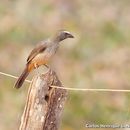en
names in breadcrumbs


The bluish-grey saltator or blue-gray saltator (Saltator coerulescens) is a passerine bird in the tanager family Thraupidae that is widespread in the tropical Americas.
The bluish-grey saltator was formally described in 1817 by the French ornithologist Louis Jean Pierre Vieillot under the binomial name Saltator coerulescens.[2] Vieillot based his description on the "Habia de la Ceja Blanca" that Félix de Azara had described in 1802 in his book on birds in Paraguay and the Río de la Plata.[3][4] The specific epithet coerulescens is derived from Latin and means "bluish".[5] The cinnamon-bellied (Saltator grandis) and olive-grey saltators (Saltator olivascens) were previously considered subspecies,[6] together known as the greyish saltator.
On average, the bluish-grey saltator is 20 cm long and weighs 52 g. The plumage depends on age and subspecies, but in general this bird has grey or greyish-olive upperparts, a white stripe over the eye, a narrow white throat, a grey breast and a buff or cinnamon belly.
The common call is a long-drawn upward slur, ch'wheeet or ch'kweeee, sometimes with a more elaborate beginning, as hi'whee chu weeeeh. The song is a warble, usually fairly short, varying from nasal to mellow.[7]
This species occurs in open woodland, plains and scrub, in Bolivia, Brazil, Paraguay, Argentina, and Uruguay.
The bluish-grey saltator feeds on fruits,[8] buds and slow-moving arthropods. It forages at low and middle levels, sometimes in pairs or small groups and sometimes with mixed-species flocks that may include other saltators.[7]
The two pale blue subelliptic eggs per clutch measure some 23–31.5 mm long by about 17–22 mm wide and weigh about 5 grams each. They look unusual for this genus as they have a circle of blackish-brown hairstreaks and dots around the blunt end.[9] They are laid in a bulky cup nest 2–4 m high in a tree.
The bluish-grey saltator or blue-gray saltator (Saltator coerulescens) is a passerine bird in the tanager family Thraupidae that is widespread in the tropical Americas.